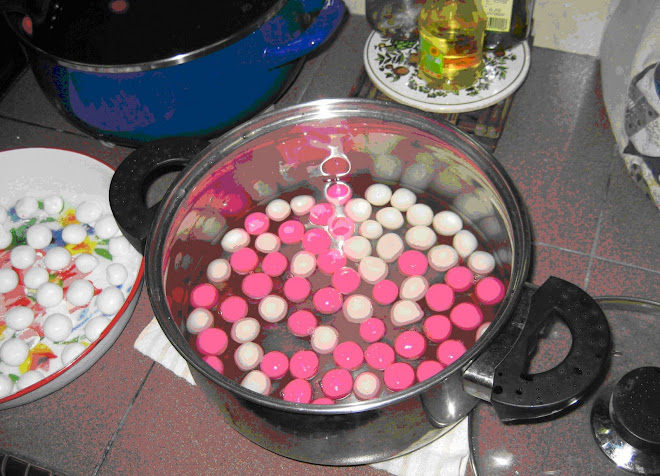The first day of winter heralded not
just a change of seasons, for me, it was the start of learning and
exploring the natural, local world of edibles around me. I have always
been interested in finding out what's edible and what isn't. I
suppose the fear of being lost and starving in the wilderness has
fuelled some of this curiosity. I am known to wonder out loud if the
ducks and swans in the lakes are edible. Channel
Living (Woodbridge's not-for-profit community organisation) put
together a foraging workshop with the help of the knowledgeable and passionate Paulette Whitney from
Provenance Growers recently.
My first introduction to foraged foods
go back to high school where I remember vividly an Indigenous bush
tucker chef came to demonstrate to our Home Economics class a lesson
in Indigenous foods. We tried all sorts of bush tucker – Davidson's
plums, warrigal greens, lemon myrtle, quandongs, macadamias and a few
wriggly specimens. I remember the fat, creamy Witchetty grubs being
flash fried in butter. Not wanting to be squeamish, I tried one and
then a second one – they tasted a bit like prawns I remember.
Rather delicious! I have not forgotten that Home Ec lesson and have
always longed to be able to repeat that day of experimenting with
food that was completely alien to me.
The foraging workshop took
place in one of the Co-op member's property. The property is up in the hills of Birchs Bay with stunning views overlooking
d'Entrecasteux Channel and Bruny Island. From above we could see
clouds rolling in on the horizon and down below, in the calm waters
were floating big pens of salmon where aquaculture, I believe is
thriving. Paulette had brought some samples with
her and laid out on the table were specimens she had picked from her
property and from nearby parks. These were then passed around so we
could all try.
(view from the hills of Birchs Bay)
(beautiful day for foraging)
These were some of the plants we tried:
sea celery/sea parsley
samphire
sea blite
chick weed
flick weed
sheep's sorrel
corn spurry
shepherd's purse
mallow
fat hen
fumitory
borage
nettles
cress
(table full of edibles)
(the blackberry nightshade)
Some of the plants that stood out for
me were sea celery with its lovely salty flavour, samphire – little
pops of salt and texture, sheep's sorrel with its refreshing lemony
aftertaste, fumitory for its bitter effect and nettles for its slight
buzzy tingling in my throat. I must say after a morning of trying all
sorts of plants and weeds – the herbaceous, grassy green
after-taste lingered long in my mouth.
(silver wattle)
We walked around the property to see
what we could forage and we did find a few things. Some of the edible
things we found on our walk were: buckhorn plantain (a common weed in
lots of gardens); blackberry nightshade, Hawthorn, red native
currants, Kangaroo apples (make sure the berries are super ripe
before you eat them). Silver wattle flowers, according to Paulette
make a good sweet addition to pancake batter. She continued to tell
us that Spanish heath flowers were being used to smoke
mutton birds as part of the Savour Tasmania food festival. That would
have been an interesting combination! I learned that tree ferns are
edible although at the expense of the plant – as to crack open its
starchy heart would mean killing the tree. Native cherry berries are
also edible, reeds. clumps of miners lettuce and sticky weed were
among some of the found edibles in the property. There were a few
more edibles I didn't quite catch unfortunately. A few helpful tips
cropped up too in Paulette's workshop. Fumitory is used in
cheesemaking to curdle milk. Plantain is good for healing cuts and
wounds, petty spurge's milky sap is used to treat skin cancers and
eczema.
Another important thing to note with
foraging is that with some plants look like other plants and one can
easily mistake a poisonous plant for an edible one. I certainly made
that mistake – in certain section of our own property I've seen a mass
of what I thought to be comfrey, luckily I checked with Paulette.
These turned out to be the not so edible Fox Glove. She also made us aware of the fashionable trend of restaurant chefs foraging for
ingredients - with Tasmanian chefs leading the way - and it makes sense when we have such a variety of edibles right on our doorstep.The good news is I have
buckhorn plantain, Spanish heath, sticky weed and fumitory growing
everywhere, a ton of forget-me-nots and nasturtiums and a
good-looking silver wattle which I intend to add to my pancakes. I
don't think I'll look at 'weeds' the same again but now, at least, I
don't just have the sole option of composting them – I can choose
to eat them as well. Imagine eating more than a dozen herbs and
plants all collected from your garden – give your lettuce and
rocket salad a break and your body will thank you for the diversity
of minerals and vitamins you're introducing to your system.
For more information on the good things that Channel Living do - visit:
For a thorough read on Tassie's wild grown and cultivated foods, and thoughtful writing, read:
(of course, i couldn't resist taking a pic of this cute fungi growing out of this piece of dung)







No comments:
Post a Comment